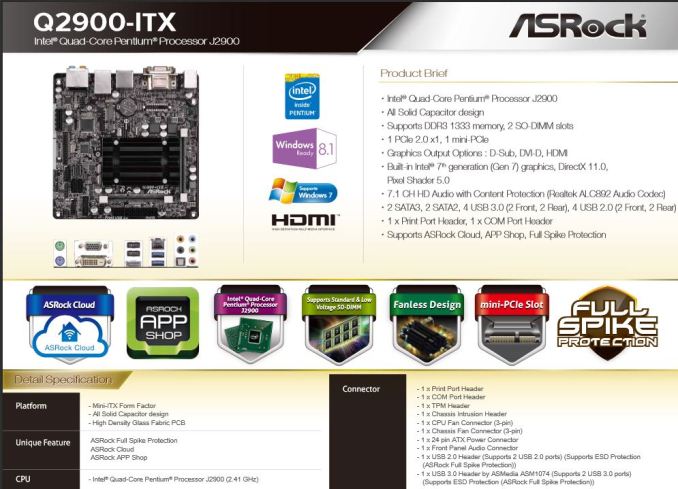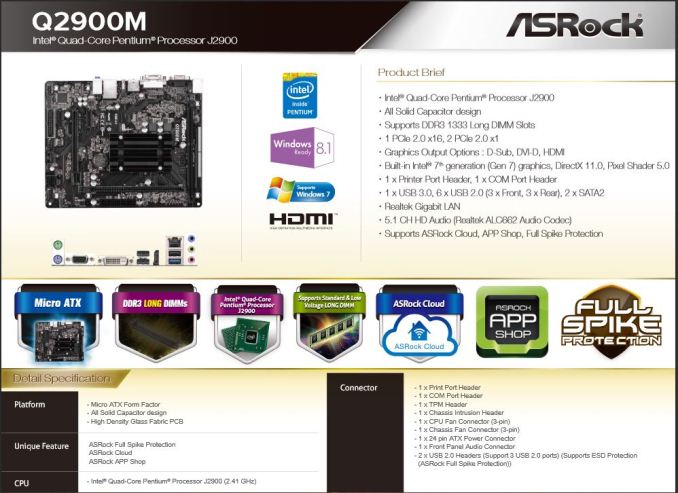More Fanless Bay-Trail: ASRock Releases Two Pentium J2900 Motherboards
by Ian Cutress on August 6, 2014 10:00 PM EST- Posted in
- Motherboards
- Atom
- ASRock
- Bay Trail

When we looked at AMD’s Kabini platform, AMD in its press materials pitted their high end APU against the Pentium J2900 in terms of price and performance. The only issue from the reviewer’s standpoint was the availability of the Pentium J2900 in a retail product. At the time, the J2900 was found only in OEM devices, or a single system was found through Google Shopping. Fast forward a few months and we are now seeing a small wave of J2900 motherboards coming to market for custom home builds. ASRock look poised to release the Q2900-ITX and Q2900M to meet that demand.
As both motherboards are using the quad core J2900 at 2.40 GHz (2.66 GHz turbo) and 10W, both are supplied with large fanless heatsinks to provide the cooling. The CPU is soldered on to the motherboard (this is an Intel limitation) meaning upgrading is not possible, but the CPU does offer dual channel DDR3, 2 MB of L2 cache and Intel HD graphics.
The Q2900-ITX is an ITX motherboard that relies on SO-DIMM DDR3 memory. The standard Atom chipset ports are here – two SATA 6 Gbps, two SATA 3 Gbps, four USB 3.0 ports, a PCIe 2.0 x1 slot, a mini-PCIe slot (for WiFi) and three standard video outputs (VGA, DVI-D, HDMI).
The Q2900M goes up to the micro-ATX size, which affords use of full-sized DDR3. Note how each of the DDR3 DIMMs are at right angles to each other, which comes across as really, really odd. The PCIe lane layout is a little different, giving a full sized PCIe slot capable of PCIe 2.0 x4. There is also two other PCIe 2.0 x1 slots, however judging by other motherboards of this ilk, using the PCIe 2.0 x4 will disable the other PCIe ports or vice versa.
Pricing and availability is not yet announced.
Source: XtremeHardware













24 Comments
View All Comments
T-Net - Wednesday, August 6, 2014 - link
Just want to comment that I have recently bought the celeron version of this (Q1900) and although low power it does have some issues with the HDMI slot. Mine doesn't show the bios when using HDMI (it just shows corrupted gibberish) and when using Windows 8.1 and hooked up to my TV, the resolutions wouldn't show properly (1920x1080 would overscan with no option of fixing it, and other resolutions just wouldn't fit or would be fuzzy.) So now if I need the BIOS I have to use the VGA connection, and I run OpenELEC and Plex instead of Windows as this is a HTPC setup anyway. Just food for thought.know of fence - Thursday, August 7, 2014 - link
If your TV has a DVI-in using a 5$ HDMI to DVI adapter is sometimes the only way to fix overscan related issues.MonkeyPaw - Thursday, August 7, 2014 - link
What do you mean by overscan? Is it drawing too big of a picture on the monitor? If so, there is the abilty to scale the picture in Intel's software. I have to do this (50%/50% scale) for my old SB i3 HTPC setup.DanNeely - Thursday, August 7, 2014 - link
A lot of TVs discard 20-30 pixels from each edge of the picture and stretch the remainder to fill it. This is an artifact from the CRT era where calibration/etc limits meant that it was nearly impossible to get a picture that filled the entire visible glass exactly. Dead black space around the edge looked bad so the default setup was to expand it so the edges fell on glass behind the bezel.It's still done with LCD TVs because in AB testing Joe Sixpack will say the one that has the image stretched to make everything slightly bigger looks better. If you're lucky, your TV will have at least one mode that doesn't do this; but it will rarely be explicitly labeled as such, meaning you'll have to try all of them sequentially to find it.
speculatrix - Thursday, August 7, 2014 - link
also, close captioning in the USA, and teletext service in the Europe, used "spare" lines on the raster scan to carry digital information, and relied on the TV overscan and flyback suppression to make the dots invisible.Cygni - Wednesday, August 6, 2014 - link
Fanless*leans forward*
Quad core
*leans forward*
With PCIe slot
*leans forward*
Bay Trail
*closes page*
It's frustrating that intel or the manufacturers can't see the value in using one of the 11.5W Haswell parts in this sort of build. Paired with a cablecard tuner, it would be a truly excellent media center.
I just have no faith that an Atom can handle the recording/playback of the 4-6 cable streams I will be putting into it.
vnangia - Wednesday, August 6, 2014 - link
Regretfully, I think we are too small a niche for this sort of attention. I'm still using my 35W Sandy Bridge machine from 2011 or so, having never found a better price / performance / wattage combination. Every generation or so I find myself hoping something comes out, but by the time Intel decides to make their Y/U/T parts available, the next generation is already rolling out. Who knows - perhaps AMD might do something spectacular here ... those 25W Kabinis are slowly catching up to the performance of Intel on the compute side, and still have better graphics performance. Though WMC isn't hardware accelerated, VLC has seemed to benefit from hardware acceleration.StevoLincolnite - Tuesday, August 12, 2014 - link
WMC does have hardware acceleration, you may just have to enable it.PEJUman - Wednesday, August 6, 2014 - link
look at anand's recent review of i3 surface 3 pro. it uses 6/11W haswell (i3 4020Y). The i3 benches are roughly 180-200% of asus T100 (Z3740, 2W baytrail quads).I think if you approach this analytically, the 10W baytrail is roughly comparable to 11W haswell.
1. Both have quicksync, at very similiar GPU clocks.
2. the J2900 is ~2.5GHz true quads, which should bench around 180% of Z3470 (~1.4Ghz quads).
3. the i3 4020Y is 1.5 Ghz no turbo duals with HT. again bench around 180-200% of Z3470.
in a nutshell, I would lean towards the bay-trails for cheap, heavily multithreaded application, non-customer facing GUI bound. Conversely, I'd go with the haswell Y series for tablets and other GUI based interaction devices.
Media server with 6 stream encodes... I am not quite sure any of these guys can handle it, heck I would even doubt my OC'd 4770K on handling this kind of workload smoothly.
nirolf - Thursday, August 7, 2014 - link
You seem to be quite right:http://www.cpubenchmark.net/compare.php?cmp[]=2173&cmp[]=2128&cmp[]=2115
I'm waiting for pricing on this. Or maybe something from Asus, I have their Atom mini-ITX board (with power brick) running for 4 years now. It's a bit dated.